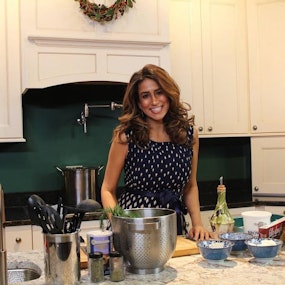In today’s episode, we cover everything about wine during the Prohibition era. I thought it would be fun to celebrate that we are NOT in the Prohibition era! To that end, join me as we circle back to some of our favorite episodes in Season One of If This Food Could Talk, and share with you some of my go-to wines that I often like to pair with these recipes.
I hope you’ll open up a bottle, raise a glass, and let me know how you liked these recipes and these pairings. I love hearing from you!
T’slem Edeik, friends. Bless your hands -
Claudia
Recipe: Persian Flatbread with Goat Cheese & Dried Apricots
Wine Pairing: Sangiovese or Chianti Classico
In Episode 2, Pizza’s Evolution from Nasty Cake to America’s Favorite Food, we looked back at the History of Pizza - from 70,000 years ago to the rise of the humble flatbread to its meteoric rise through Italy and now the rest of the world. For an awesome Persian Flatbread with Goat Cheese & Dried Apricots pairing, you can’t go wrong with a traditional, medium-bodied Sangiovese or Chianti Classico from the Tuscany region of Italy. Both the Sangiovese and the Chianti Classico have a bright red, ruby color, light tannins, and undertones of berries, earthy flavors like oregano and thyme, which complement the subtle oregano that are baked into the dough. It’s a good everyday red wine for a thin pizza full of flavor. Look for ones that have the Riserva (Reserved) label from Italy, as they must be aged for 24 months according to Italian law.
Here’s a little trick: I don’t care for warm red wines on a warm summer night. I’m funny that way. I learned while living in Cyprus to refrigerate my light and medium reds (like the Sangiovese or Chianti Classico) and pull it out of the fridge about 20 minutes before decanting. This keeps the wine fresh and paired well, even on a warm summer night - like in Tuscany! The best serving temperature for Sangiovese is 14-17°C (57-63°F).
Listen Here to the episode: https://link.chtbl.com/_7Uo7cK5?sid
Recipe: Roasted Black Olives
Wine Pairing: Cabernet Sauvignon
In Episode 3, we got groovy with olive oil. Swimming in Olive Oil: An Ancient Love Affair transported us to Ancient Greece and had us falling in love with the Vouves tree of Crete. We learned how to cook with, pair, and store extra virgin olive oil. I shared my favorite Roasted Black Olives that will have your dinner guests sopping up the caramelized garlic with fresh bread. I always pair this recipe with a deep, rich Cabernet Sauvignon. The earthier, the heavier, the better. The oil-cured olives are quite meaty and they require a heavy red to complement it. Because I like a heavy red for this olive recipe, I suggest looking out for some 2019-2020 bottles coming out of Napa, Sonoma, or Paso Robles in California or Walla Walla County in Washington. An inexpensive, but yummy go-to for me is Clos de Napa - Rutherford Cabernet Sauvignon or the J. Lohr Cabernet Sauvignon from Paso Robles.
Recipe: Nicoise Salad with Homemade Caesar Dressing
Wine Pairing: Dry Rosé
In Episode 5, I had the complete pleasure of chatting with legendary Chef Jacques Pépin in Long Live Leftovers: Chef Jacques Pépin on the Joy of Thrifty Cooking. Inspired by Jacques ethos to use whatever was in my fridge, I created an impromptu Nicoise Salad with a knock-your-socks-off Homemade Caesar Dressing. In this dressing, I lean into the umami flavors of Dijon mustard and chopped up anchovies in olive oil (or anchovy paste). I promise: it does not taste too fishy. But instead, it gives your greens a layer of depth I normally don’t get with usual salad dressings. When I think of my Nicoise Salad, I dream about jetting off to the South of France and hanging with beautiful people. Instead, I will sip on a dry rosé , stare out at my falling leaves in Central Virginia, and reminisce about long summer days and chill wines.
When choosing a rosé , I go down under - to South Africa. I had the pleasure of visiting Cape Town a couple years ago and was blown away by its sheer beauty. The scale of the cliffs crashing down into the chilly, tumultuous collision of the Atlantic and Indian Oceans was unforgettable. Also unforgettable were the wonderful, small vineyards that filled the countryside. Whenever I want to conjure up memories of that trip, I reach for a South African rosé from a primarily Cinsault grape. I can easily find one without breaking the bank for under $20.
Recipe: Bison Meatballs with Cranberry Agave Glaze
Wine Pairing: Pinot Noir and/or Riesling
In Episode 6, we visited the Heartland of America and rediscovered the oldest and newest American culinary foodways. The Bison Are Back: Reclaiming Native American Foodways is a gorgeous story about Jayme Murray, a Lakota bison rancher, and Ben Jacobs, a Denver-based, Osage chef, working together to get indigenous American cuisine on our tables. With Ben’s help, I recreated his tasty Bison Meatballs with Cranberry Agave Glaze with huge success. I had a little dinner party with my family and some friends so we could try the meatballs together and pair them with wine. Here is what we discovered: I liked having BOTH a red and white wine with this meal! Let me explain.
The bison meat is hearty, but not heavy like many traditional beef-based meatballs I’m used to making. Therefore, we enjoyed eating them with a light red wine. I’m a lover of good Pinot Noir from the Willamette Valley in Oregon. Price points for Pinot Noir wines from this region are all over the place. One that I always have in my house is Josh - it’s inexpensive and reliable if I ever need a quick wine, this is on-hand. But I also enjoy Domaine Drouhin reserves, as a good midrange wine. You can really taste the berries in these Pinots, which complement the rehydrated cranberries used in this recipe.
I must admit, once I added the Cranberry Agave Glaze to the bison meatballs, the entire dish got more fruity and sweet (hello agave). To that end, I wanted to cut the sweetness with a bit of acidity from a white wine. I chose a Riesling. We happened to have on hand a New York Riesling at the house, but typically I love German Rieslings. The Riesling balanced out the cranberry agave sauce, which had some orange citrus cooked in. The flowery tones of the Riesling played well with the agave glaze. I served all this with an arugula salad that had a bright lemon/orange/olive oil dressing and toasted pecans. It all worked spectacularly. I hope you give it a try!
Do you have a good wine pairing suggestion? I’d love to hear it! Send me a note here or on social media.













